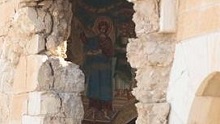Abandoned churches near site of Christ’s Baptism may open again
 “Ghost” churches near the Jordan River, where St. John the Forerunner baptized the Lord Jesus Christ, could be reopened to pilgrims as part of an effort to remove booby-traps and land mines, reports Reuters.
“Ghost” churches near the Jordan River, where St. John the Forerunner baptized the Lord Jesus Christ, could be reopened to pilgrims as part of an effort to remove booby-traps and land mines, reports Reuters.
Thousands of mines litter the river banks which once served as a war zone between Israel and Jordan. Following its 1967 capture of the West Bank, Israel booby-trapped some of the area’s seven now-abandoned Orthodox and Catholic churches as protection against Jordanian incursions.
The two nations made peace in 1994, but mine clearing took several years to begin. The Halo Trust, a Scottish-based charity, is now looking to raise $4 million to clear the expected 4,500 mines on the western side of the river. The mined area is only half a mile from an already cleared site at Qasr al-Yahud (about a half hour drive from Jerusalem), where Christian pilgrims already come in great numbers. The foundation says it will need two years to clear the area, making it safe to open the churches once again, and that its work is supported by Israeli, Jordanian, and Palestinian authorities.
It is unclear precisely where the Gospel’s referenced “Bethany beyond the Jordan” is to be found, both nations claiming it is on their side of the river. The first evidence of a monastery near the place of the Lord’s Baptism dates to the sixth century, when it was mentioned that a monastery was erected by the orders of Byzantine emperor Anastasius I (491-518), according to Sedmitza.
The Jordanian side was declared a UNESCO World Heritage Site in 2015, after opening in 2002. The Israeli site opened in 2011, and receives more visitors, although its churches have remained closed.
“Every year these places attract more than 450,000 tourists and pilgrims from all over the world, and we are confident that the local economy will flourish after the mine clearance on the territory of the churches, and their restoration,” said Ronen Shimoni, the Halo Trust’s mine clearance project manager.
The team tasked with clearing the mines consists of thirty-five to forty “sappers,” most coming from Georgia.
Source: Pravoslavie.ru

